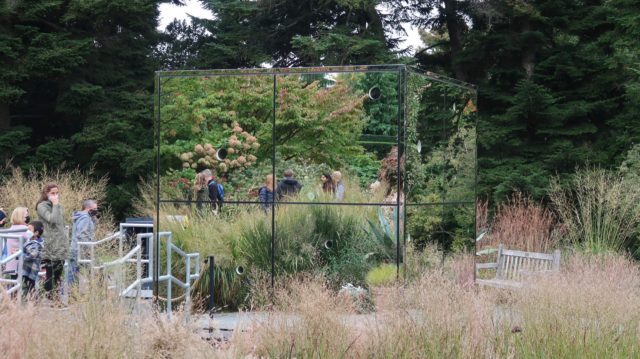
Yayoi Kusama’s Infinity Mirrored Room — Illusion Inside the Heart sits like a UFO in a grassy field at NYBG (photo by twi-ny/mdr)
KUSAMA: COSMIC NATURE
The New York Botanical Garden
2900 Southern Blvd., Bronx
April 10 – October 31, $15 children two to twelve, $35 adults, $10 for Infinity Room, 10:00 am – 6:00 pm
718-817-8700
www.nybg.org
online slideshow
“How vast and boundless the provisions of nature!” Yayoi Kusama has declared. The ninety-two-year-old Japanese artist has been attracted to the natural world since she was a little girl, when her grandmother ran a plant nursery in Nagano, and she later studied the nihonga style of painting, dating back to the Meiji Period, which depicts scenes from nature through a contemporary artistic lens. Kusama’s fascination with living things is on display in the endlessly fun exhibition “Kusama: Cosmic Nature,” which continues at the New York Botanical Garden through October 31.
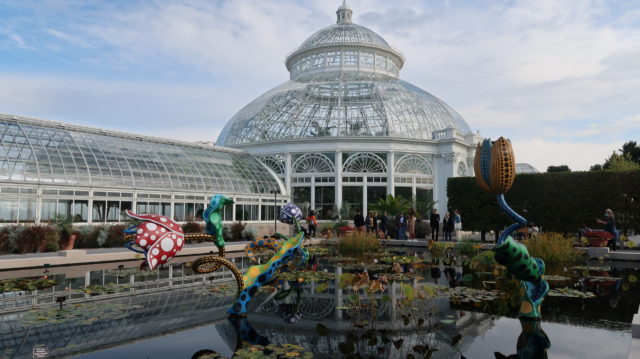
Hymn of Life — Tulips emerge out of the Conservatory Courtyard Hardy Pool (photo by twi-ny/mdr)
The show, comprising drawing, painting, sculpture, video, and installation, opened in April, but it has taken a distinct turn this fall, adapting its focus to pumpkins and chrysanthemums. “My pumpkins, beloved of all the plants in the world,” Kusama said. “When I see pumpkins, I cannot efface the joy of them being my everything, nor the awe I hold them in.” For the final month, the garden has brought in hundreds of real gourds, lining the flights of steps leading to the LuEsther T. Mertz Library Building and the Enid A. Haupt Conservatory; in addition, three enormous real pumpkins are on plinths outside the conservatory, each weighing more than a ton.
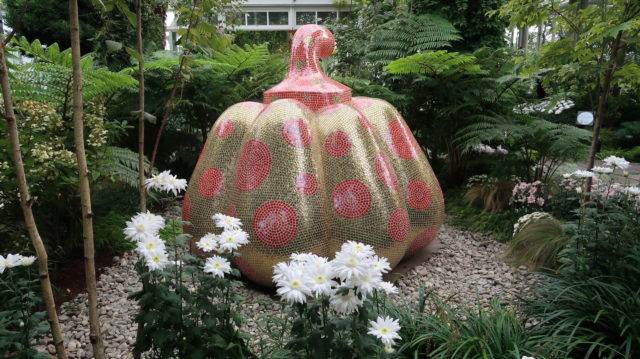
Starry Pumpkin occupies the place of honor in the Enid A. Haupt Conservatory (photo by twi-ny/mdr)
Several of Kusama’s small and large-scale pumpkins are scattered throughout the 250-acre Bronx oasis. Starry Pumpkin (2015) has the place of honor in the center of the conservatory, a glittering object surrounded by red, white, and yellow chrysanthemums in arrangements based on Kusama’s 2014 painting Alone, Buried in a Flower Garden (which is on view in the library), along with sections inspired by the Kengai (Cascade) style that resembles flowers hanging over a cliff, and the kiku method of Shino-tsukuri (Driving Rain) that gives the plants a windblown appearance. Inside the library are also the acrylic and felt pen on canvas Pumpkin TWOTOEL (2004) and soft sculptures of pumpkins from 2016 entitled The Sun Has Gone Down, I Am Scared as Much as Being Alone and Suppressing the Burning Desire for Death, which give an indication of Kusama’s longtime exploration of life and death and the often unusual names she gives her works.

Visitors are allowed to walk under Kusama’s Dancing Pumpkin (photo by twi-ny/mdr)
Near the conservatory is the monumental Dancing Pumpkin (2020), a black and yellow creature you can walk under that resembles one of Louise Bourgeois’s spiders, while Pumpkins Screaming About Love Beyond Infinity (2017) lights up and creates mirrored views that seem to go on forever in the Visitor Center Gallery. “What appealed to me most was the pumpkin’s generous unpretentiousness,” Kusama has explained. “That and its solid spiritual balance . . . its fat belly and unadorned features . . . its burly, psychological power.”
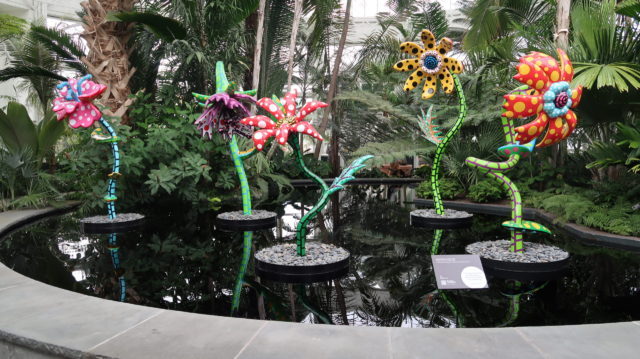
My Soul Blooms Forever welcome people inside the conservatory (photo by twi-ny/mdr)
But “Kusama: Cosmic Nature” is a lot more than just pumpkins. The longest line is for Infinity Mirrored Room — Illusion Inside the Heart (2020), which sits in the middle of a field of tall grass and in between two small gardens, like a UFO landing in the country; holes in the exterior change the inside lighting and allow you to peer inside, where you will see your own face on the other side. I Want to Fly to the Universe (2020) is a smiling red, white, and blue star residing in the reflecting pool outside the Visitor Center. For Narcissus Garden (1966/2021), Kusama has placed 1,400 stainless-steel shiny balls bobbing atop a pond in the Native Plant Garden. Ascension of Polka Dots on the Trees (2002/2021) consists of trees wrapped in red polyester covered in white polka dots. Hymn of Life — Tulips (2007) features three large, colorful, childlike flowers in the Conservatory Courtyard Hardy Pool. The five waterbound urethane-painted stainless-steel flowers of My Soul Blooms Forever welcome people inside the conservatory. The exhibit also includes the obliteration greenhouse Flower Obsession (2017/2021), complete with household items and plastic stickers. Inside the Ross Gallery is a timeline and the multiscreen Walking Piece (1966/2021) composed of stills from one of Kusama’s most well known performances, wandering through New York City in a kimono and under an umbrella.
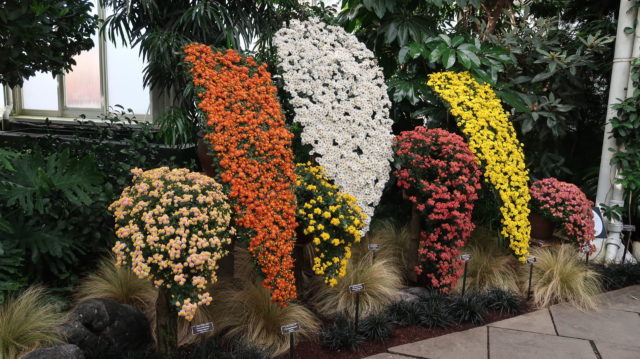
Chrysanthemum arrangements are inspired by the Kengai (Cascade) style that resembles flowers hanging over a cliff (photo by twi-ny/mdr)
“I am happy that I have painted flowers. . . . There are no objects more interesting,” Kusama, who has voluntarily lived in a Tokyo psychological institute since 1977 and still works every day in her nearby studio, has stated. As “Kusama: Cosmic Nature” reveals, Kusama has created a lot of other parts of the living world, all pieces of an endless universe that exists beyond death, in her deeply personal futuristic environment that is filled with abounding wonder.